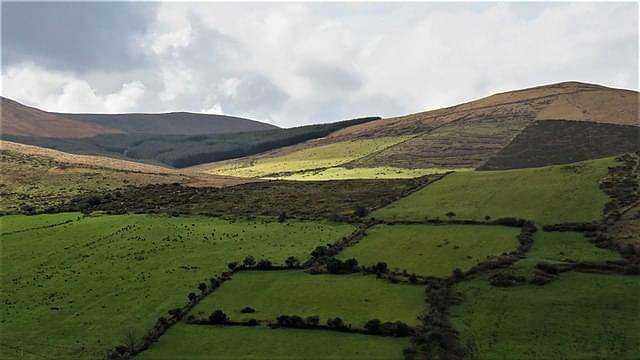Eilín Ní Bheaglaoich’s albums include Míle Dath: A Cloak of Many Colours and Béilín Meala, with her musical interests resting in the classical music tradition meeting the Irish traditional one. She is a published author of poems and short stories, as well as having been a faculty member of Maynooth University’s Irish department. While a primary school teacher in Australia, she pursued postgraduate work in psychology and a career in radio broadcasting.
Éilís Ní Chinnéide’s albums include Westward and So Ends This Day. Both albums are rooted in oceanic influences and the realities created from such a presence. She has collaborated with another Kerry born singer, Pauline Scanlon, to form the acclaimed duo Lumiere, travelling across many oceans in doing so. Together they have performed for international audiences, from Australia’s Melbourne Recital Hall to America’s Carnegie Hall. She has worked with her sister, poet Dairena Ní Chinnéide, to set poetry to music, cementing not just her interest in Irish poetry but in its impact today.
Self-assured, breathtaking and decidedly avid, the land slips into sea, as natural but as striking as one tune into the next. Born here, in County Kerry, the singer and songwriter Éilís Ní Chinnéide grew up in the hands of this musical landscape: “Our parents and grandparents were teachers in the local school and instilled a love of songs and books, as well as a deep appreciation of our surroundings and community.” When remembering her childhood, she recalls how singing was as organic as talking. Born across the river from Ní Chinnéide, Eilín Ní Bheaglaoich, a sean-nós singer, writer and former teacher remembers her father coming home to play polkas and slow airs on the family’s accordion. Now, we enter into a conversation about both creatives’ deep connection to music and the ever inspiring Irish landscape.
“Ní Bheaglaoich and Ní Chinnéide shared how their own song recordings and artistic collaborations took flight as adults.”
Ní Bheaglaoich explains, “We were listening, but we weren’t sitting and listening, nine children with my mother, we all had jobs to do…my father would then put the accordion up on top of the dresser, and whoever was tall enough to take it down, so my sister Máire, she’d start playing it as well! It went all through the nine children.” Yet, both Ní Bheaglaoich and Ní Chinnéide shared how their own song recordings and artistic collaborations took flight as adults. Shared as one of Ní Chinnéide’s most memorable projects, a song cycle named Béal Tuinne (The Breaking Wave) was born of poems written by her father Caoimhín Ó Cinnéide. Shaun Davey (a composer and Trinity graduate) reassembled the pieces with original compositions. “Many poems are rooted in our local community and it was fitting that people who are very special to my family were all involved…leading to a lifelong friendship with Shaun Davey and his wife Rita Connolly, whose singing I had always loved,” says Ní Chinnéide. The artists toured extensively with this project, from The National Concert Hall to the Centre Culturel Irlandais in Paris. However, Ní Chinnéide recalled the performance at Trinity College Dublin as being truly special.
“…poetry that’s at the heart of the Irish song tradition is inseparable from the Irish landscape through its employment of pathetic fallacy, myth and metaphor.”
When Ní Bheaglaoich returned to Ireland after having lived in Australia, she was contacted by Gabriel Byrne to coach the cast in Irish for the play Draíocht (Magic). After their performance at Trinity College Dublin, Ní Bheaglaoich sang one of her favourite songs, An Bínsín Luachra (The Little Bench of Rushes). Ní Bheaglaoich shared that the poetry that’s at the heart of the Irish song tradition is inseparable from the Irish landscape through its employment of pathetic fallacy, myth and metaphor: “A lot were travelling poets…they could sleep in ordinary houses as they went along the way because in the houses they had rushes near the fire. The person who would come in would lie down and have a rest, but it was he or she, mainly he who would be walking through the countryside describing it.” Although engaging with differing audiences also gives musicianship an endlessly rambling sound, Ní Chinnéide returns to West Kerry. She recalls the reciprocity in this homecoming: “Sharing makes art last. For me songs are like seeds when they are heard. I go back to the fertile soil of West Kerry to see what I have received from those before me. That soil is kept fertile, in turn, by new influences and fresh outlooks which preserve the old in language and nuance, while remaining relevant and alive.”
“Ní Bheaglaoich also spoke about time and perspective when reflecting on the fire that destroyed her home on August 20th, 2022.”
Ní Bheaglaoich also spoke about time and perspective when reflecting on the fire that destroyed her home on 20 August 2022. Once the house her mother grew up in and the home where she spent her childhood, she now thinks of womanhood, coaction and regrowth. These ideas of ancestry and responsibility, with the identity and permanence they make together, was endorsed beautifully by Ní Chinnéide when she said, “I would consider it no different at all from the notion that Mount Brandon will always be there, or the view of the Three Sisters from Dúinín.”
Now, both Ní Chinnéide and Ní Bheaglaoich watch as the Dingle Peninsula steps away from summer and into autumn. As the bustle that comes with school holidays and tourism begins to ease into scattered footsteps, the shift in the atmosphere of this landscape offers reflective, creative potential. Attentiveness is asked for when a singer begins her song, but it’s also often needed for such a beginning to be possible.






